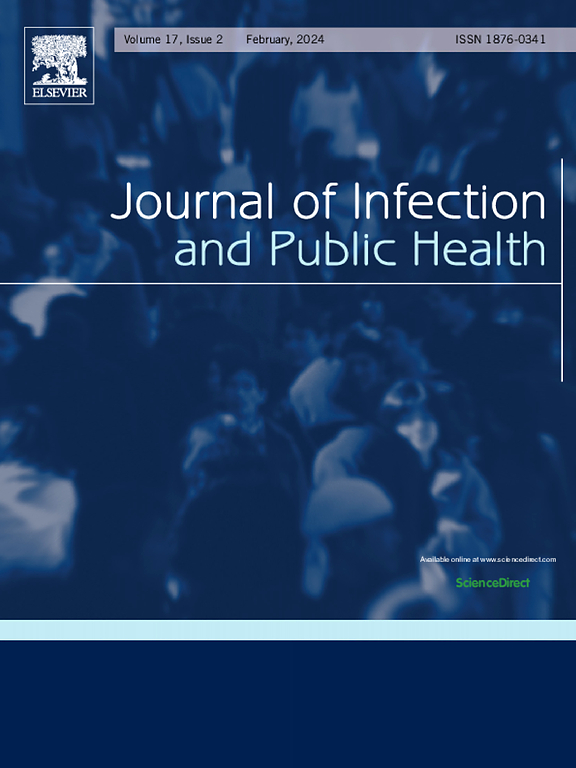Superspreading potential of SARS-CoV-2 across multiple infection generations
IF 4
3区 医学
Q1 INFECTIOUS DISEASES
引用次数: 0
Abstract
Background
Early during the coronavirus disease 2019 pandemic, the first patients to be identified as the source of infection in the clustered outbreak of severe acute respiratory syndrome coronavirus 2 (SARS-CoV-2) were labeled superspreaders in South Korea. However, the extent to which superspreading potential varies across different infection generations remains unclear. This study aims to estimate SARS-CoV-2 superspreading potentials across different infection generations from the largest clustered outbreak of the SARS-CoV-2 wild type in Seoul, South Korea, 2020.
Methods
We retrieved the infector–infectee line list data on an outbreak occurred between May 6 and June 5, 2020. To evaluate the superspreading potential (), we fitted the offspring distributions that had been acquired by counting the number of observed secondary infections for each case and each generation into negative binomial distributions.
Results
The outbreak yielded a value of 0.18 (95 % confidence interval [CI]: 0.13–0.27) and similar superspreading potentials across the different infection generations. Regarding the superspreading potential in each generation (i.e., individuals’ heterogeneity across different generations), was estimated to be 0.27 (95 % CI: 0.15–0.51), 0.14 (0.03–0.23), 0.10 (0.01–0.17), 0.55 (0.12–5.80 ×105), and 0.19 (0.07–0.73) for the first, second, third, fourth, and fifth or more generations, respectively.
Conclusions
Our findings revealed no significant variations in the superspreading potential of SARS-CoV-2 across cases from different infection generations in the clustered outbreak. Assessing superspreading potential during the epidemic is necessary to refine epidemic modeling and enhance public health understanding of the transmission dynamic of epidemics.
SARS-CoV-2在多代感染中的超传播潜力
早在2019年冠状病毒病大流行期间,韩国首批在聚集性暴发的严重急性呼吸综合征冠状病毒2 (SARS-CoV-2)中被确定为感染源的患者被标记为超级传播者。然而,不同感染世代之间的超传播潜力差异程度仍不清楚。本研究旨在估计2020年韩国首尔最大的SARS-CoV-2野生型聚集性暴发中不同感染代的SARS-CoV-2超传播潜力。方法检索发生在2020年5月6日至6月5日之间的一次疫情的感染-感染线列表数据。为了评估超传播潜力(k),我们通过计算每个病例和每一代观察到的继发感染数量,将后代分布拟合为负二项分布。结果本次暴发的k值为0.18(95%可信区间[CI]: 0.13-0.27),不同感染世代的超传播潜力相似。对于每一代的超扩散潜力(即个体在不同代之间的异质性),k估计分别为0.27 (95% CI: 0.15-0.51), 0.14 (0.03-0.23), 0.10 (0.01-0.17), 0.55 (0.12-5.80 ×105)和0.19(0.07-0.73),分别为第一代,第二代,第三代,第四代和第五代或更多代。结论在聚集性暴发中,SARS-CoV-2的超传播潜力在不同感染世代的病例中无显著差异。评估流行病期间的超传播潜力对于完善流行病建模和增强公共卫生对流行病传播动态的理解是必要的。
本文章由计算机程序翻译,如有差异,请以英文原文为准。
求助全文
约1分钟内获得全文
求助全文
来源期刊

Journal of Infection and Public Health
PUBLIC, ENVIRONMENTAL & OCCUPATIONAL HEALTH -INFECTIOUS DISEASES
CiteScore
13.10
自引率
1.50%
发文量
203
审稿时长
96 days
期刊介绍:
The Journal of Infection and Public Health, first official journal of the Saudi Arabian Ministry of National Guard Health Affairs, King Saud Bin Abdulaziz University for Health Sciences and the Saudi Association for Public Health, aims to be the foremost scientific, peer-reviewed journal encompassing infection prevention and control, microbiology, infectious diseases, public health and the application of healthcare epidemiology to the evaluation of health outcomes. The point of view of the journal is that infection and public health are closely intertwined and that advances in one area will have positive consequences on the other.
The journal will be useful to all health professionals who are partners in the management of patients with communicable diseases, keeping them up to date. The journal is proud to have an international and diverse editorial board that will assist and facilitate the publication of articles that reflect a global view on infection control and public health, as well as emphasizing our focus on supporting the needs of public health practitioners.
It is our aim to improve healthcare by reducing risk of infection and related adverse outcomes by critical review, selection, and dissemination of new and relevant information in the field of infection control, public health and infectious diseases in all healthcare settings and the community.
 求助内容:
求助内容: 应助结果提醒方式:
应助结果提醒方式:


